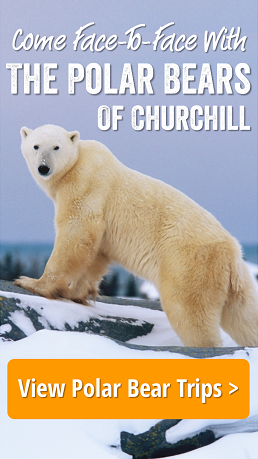by Steve Selden | Feb 10, 2015 | Churchill News
Traveling to Churchill evokes images of pristine white polar bears. This “white” fur blends in with snow and ice to camouflage the animal, not from predators, though more so from prey, such as seals. The black also acts as a receptor for heat absorption from sunlight.

Polar bear with blackish tongue. Natural Habitat Adventures photo.
Each polar bear hair is hollow in core, pigment-free and transparent that scatters and reflects sun-light. The same principle happens with ice and snow.
Just after the molting season in spring and early summer, polar bears appear most white since they are cleanest then. During the seal hunting season out on the Hudson Bay, polar bears absorb oils from the seals and appear yellow in color.
Underneath this thick “white” fur is a black skin layer with four and a half inches of fat below that.

Polar bear skin is black underneath the transparent guard hairs. Brad Josephs photo.
When a polar bear is on land or on the sea ice surface the thick fur coat is what insulates the bear from the cold. However, when polar bears are swimming in water, the thick fat layer is what protects them from the frigid cold. Wet fur is not a good insulator and for this reason mother polar bears tend to keep their cubs out of the water as much as possible. The young bears have not built up the protective fat layer yet. Their fur however is enough to survive the cool spring temperatures.
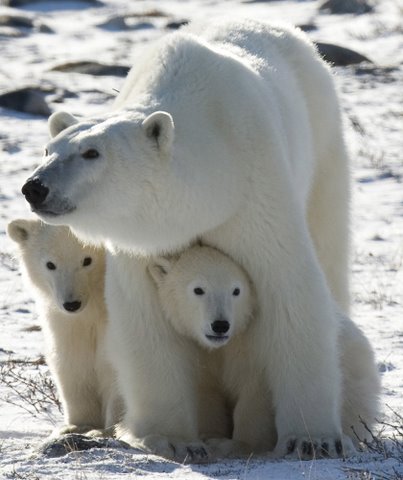
Mother polar bears avoid having their cubs swim in the ocean until they have the fat reserves to protect them. Jonathan Hayward photo.
Another unique characteristic that allows polar bears to keep warm and exude a whitish glow is luminescence. The insides of these transparent guard hairs have tiny bumps that scatter light and create a greater surface for the light across the animals body. The outside of the hairs also collect salt particles from the ocean and act in the same way to refract or scatter the light. Both of these processes cause an overall glow of white in appearance.
by Steve Selden | Feb 9, 2015 | Churchill Photography
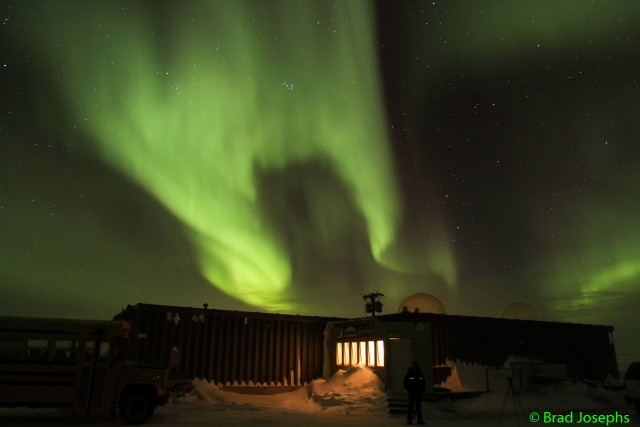
Aurora over the “aurora domes”, a prime indoor spot to photograph the lights. Photo Brad Josephs.

Natural Habitat travelers and the aurora borealis in Churchill.
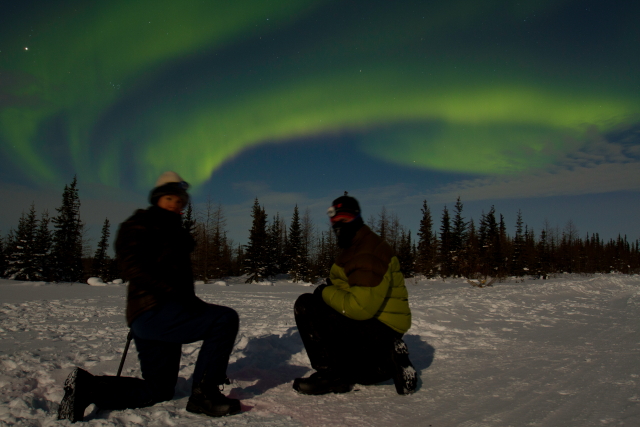
Photographers under the aurora borealis. Photo Brad Josephs.
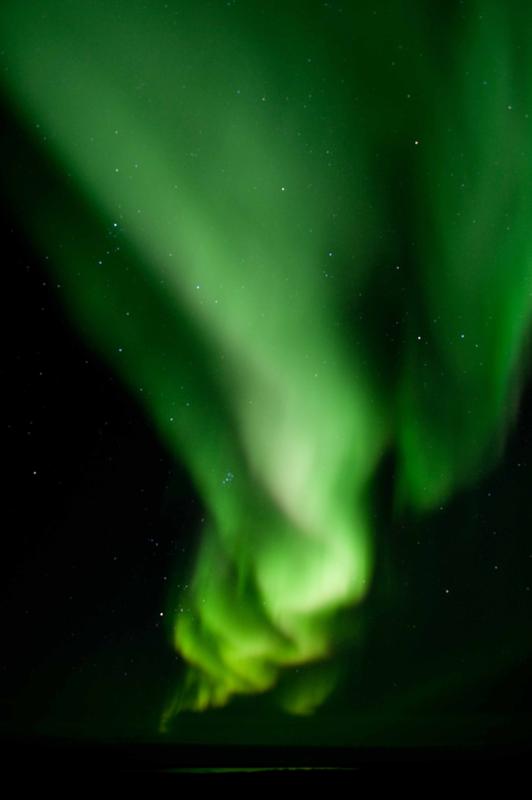
Aurora Borealis in Churchill, Manitoba. Photo Colby Brokvist.
Four iconic aurora borealis photos from Churchill, Manitoba. This year’s Natural Habitat trips have started off with fantastic northern lights viewing. We will have a field report this week from Churchill.
If you want to come see these amazing lights and experience the Arctic culture visit nathab.com today for itineraries!
by Steve Selden | Feb 7, 2015 | Churchill Photography

Natural Habitat Aurora Pod. Boris Minkevich photo.

Natuaral Habitat Aurora pod. Boris Minkevich photo.
The Natural Habitat Aurora Pod is loaded on the train and ready to head north to Churchill,Mb. When it finally comes to rest somewhere on the tundra in the Churchill region, travelers will be able to view the aurora borealis in the comfort of the pod. Stay tuned for seasonal updates through the end of March!

Aurora in the northern Churchill sky. Brad Josephs photo.
by Steve Selden | Feb 6, 2015 | Churchill News
The Hudson Bay Quest’s mushing roster has been trimmed down to 14 as the race draws nearer. Al Hardman has withdrawn his entry and Elizabeth Graves, after just qualifying in the John Beargrease Marathon in Two Harbors, MN, also had a change in plans and cannot attend. The Hudson Bay Quest starts in Gillam, MB this year on March 13th. Churchill, shrouded in snow with aurora borealis overhead ,will welcome mushers over the ensuing few days.

Churchill musher Charlie Lundie and his dog team. Steve Selden photo.
Al ran in the 2000 Iditarod and finished 37th. He then placed 21st in the 2002 Iditarod. In 2004 a virus struck his dog team on the first half of the race though he was able to nurse them to the finish in 59th place. Al is a retired CEO of his own company Hardman Construction in Michigan.
Elizabeth, a musher from Ely, MN, competed in the mid-distance leg of the Beargrease which is the longest sled dog marathon in the lower 48 states at nearly 400 miles. She was able to qualify for the Hudson Bay Quest through her efforts in the Beargrease.

Start of the 2014 Hudson Bay Quest in Churchill, Manitoba. Brad Josephs photo.
Hudson Bay Quest entrant Ryan Anderson won the Beargrease race edging out three time champion Nathan Schroeder by 28 minutes. Anderson also beat Schroeder to the finish line in 2011 by just 20 seconds.

Snowfall in Churchill piling up. Hudson Bay Quest photo.
The OFFICIAL 2015 HBQ race roster is as follows:
1.) Martin Massicotte
2.) Dan DiMuzio
3.) Dave Daley
4.) Justin Allen
5.) Tom Terry
6.) Peter McClelland
7.) Jesse Terry
8.) Jennifer Freking
9.) Charlie Lundie
10.) Blake Freking
11.) Denis Tremblay
12.) Ryan Anderson
13.) Shawn McCarty
14.) Leonard McPherson
by Steve Selden | Feb 5, 2015 | Conservation

February 27th is International Polar Bear day. The commemorative day was designated to bring to light the current plight of polar bears future fate hinging on global warming and reduced yearly sea ice in the north. The day is meant to positively encourage conservation efforts focusing on reduction of carbon output.
Natural Habitat Adventures has teamed up with World Wildlife Fund to create an incredible opportunity to symbolically adopt a polar bear in your name while at the same time venturing to Churchill, Manitoba to see these magnificent creatures in the wild.
Between today and February 27th, Natural Habitat Adventures will pay for your adoption fees through WWF when you book a Churchill polar bear adventure.
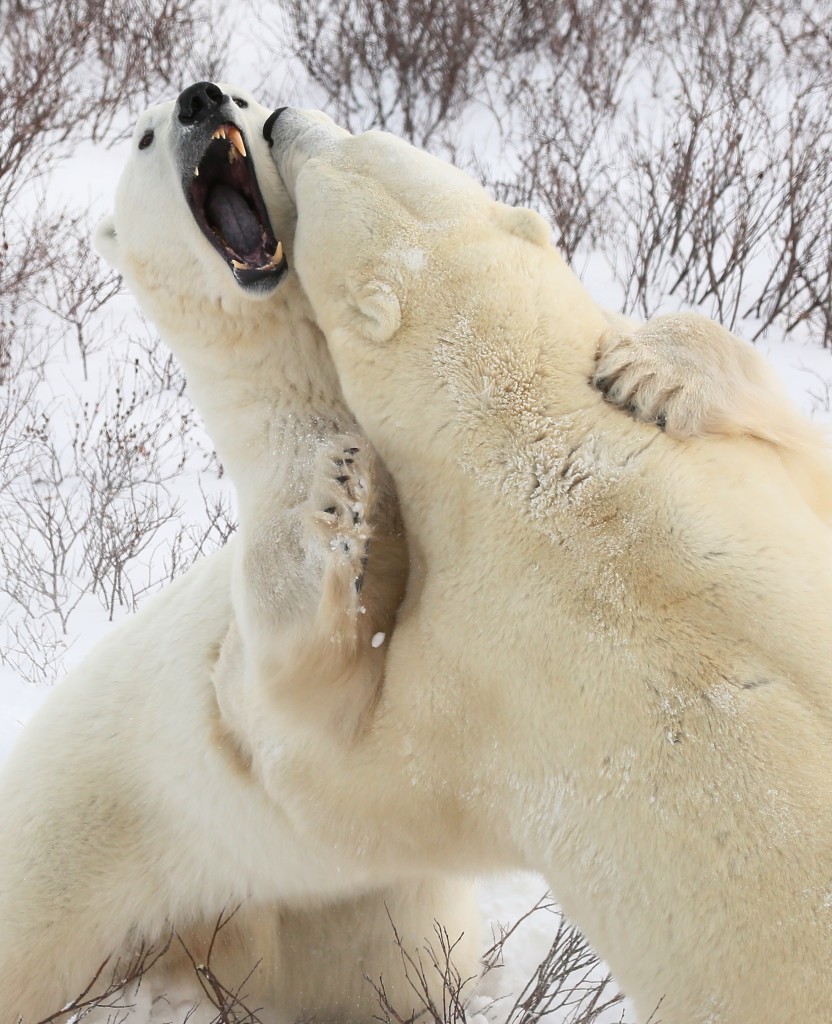
Sparring bears in the CWMA. Melissa Scott photo.
Encountering wild polar bears in their natural habitat will thrill and inspire you as well as hopefully motivate you to find ways to help protect this iconic species for the future.
If you reserve one of these trips today up to International Polar Bear Day on Feb. 27 you will receive your personal WWF adoption kit* including a certificate and species info card, frameable polar bear photo, plush polar bear toy, and reusable WWF gift bag.

















